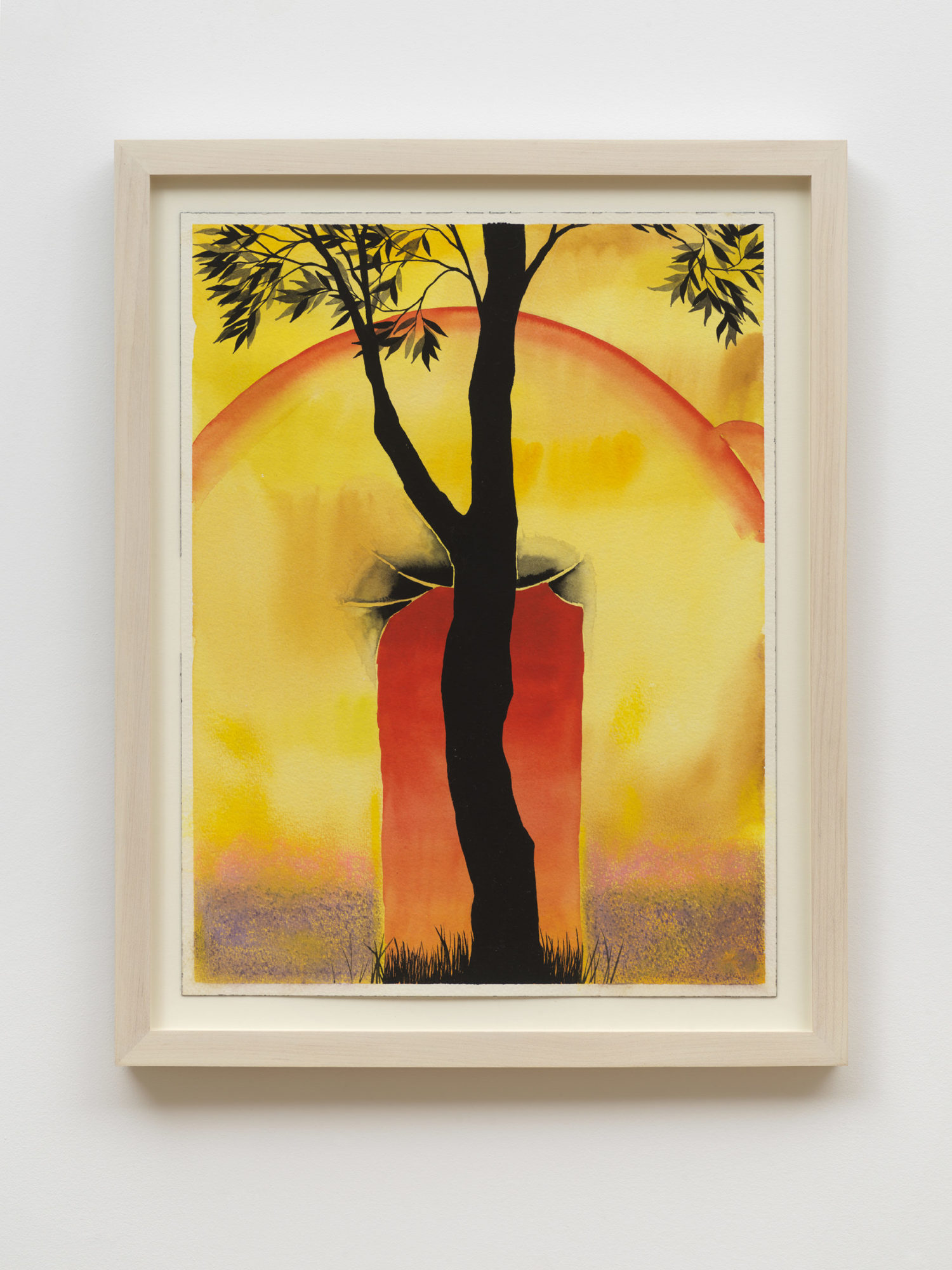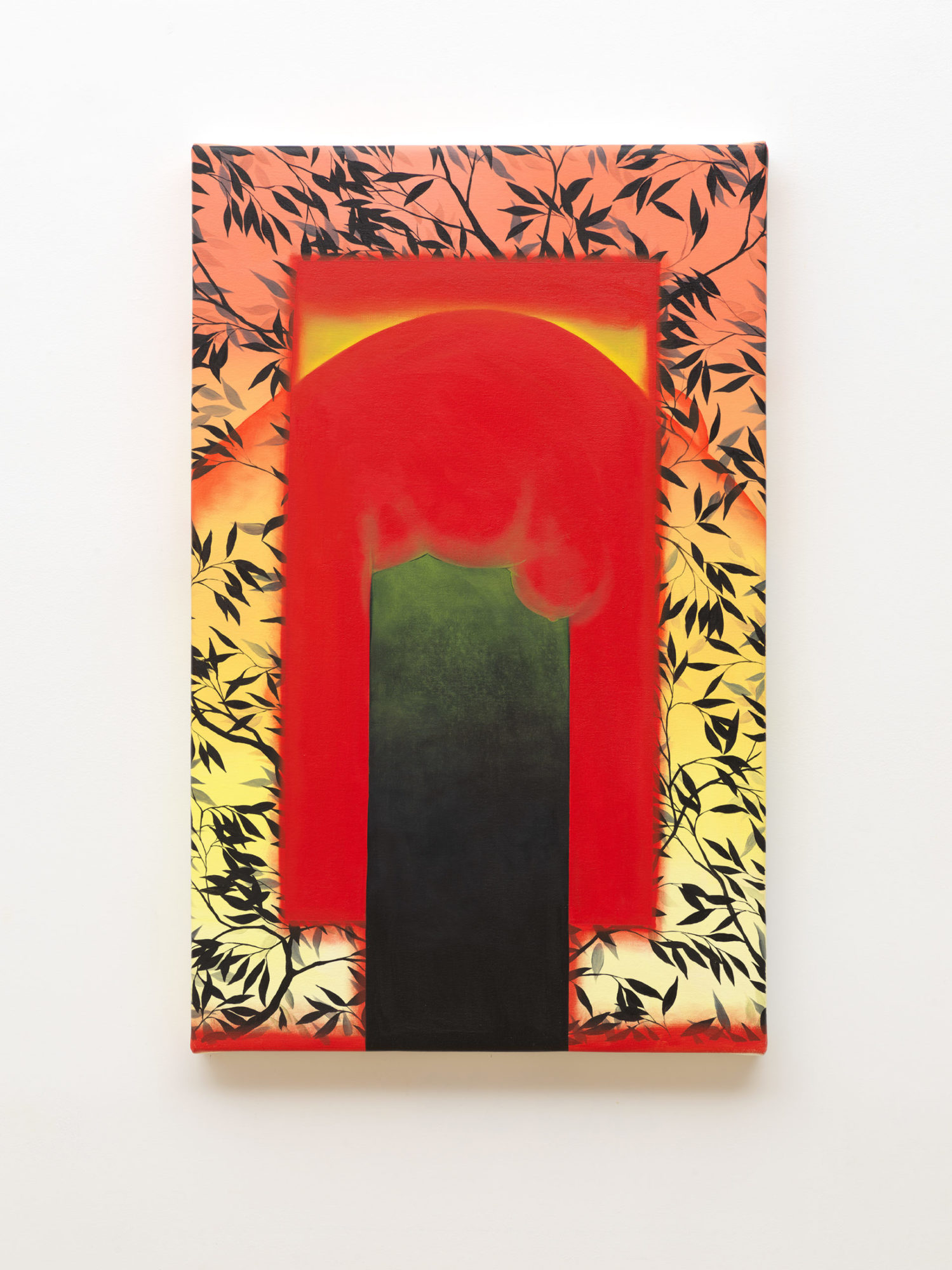Brittney Leeanne Williams: The Arch Is a Portal Is a Belly Is a Back

Brittney Leeanne Williams, A Passing Dance, 2020, oil on canvas, 54 x 89 inches [photo: Dario Lasagni; courtesy of the artist and Alexander Berggruen, New York]
Share:
The bent posture of a semi-abstracted female silhouette dominates 15 of the 17 artworks by Brittney Leeanne Williams, currently on view at Alexander Berggruen [March 5–April 14, 2021]. This show of paintings and works on paper made 2020–2021 embodies the Chicago-based artist’s investigations into the physical and psychological exhaustion of being a black woman in the United States. Sensuously folded, a recurring figure’s posture has been simplified as a smooth rounded arc to indicate the back. A few simple curves imply the breast and belly, and introduce a void beneath them. Variations come from other formal components that energize and solidify the work. In addition to her frequent use of red on the figures, which the artist discusses in various interviews as referencing the pulsing lights of ambulances in Chicago, Williams also includes subtle line work, elements of the natural environment as setting, and positions of arms and legs that create the positive and negative spaces in the compositions.
Brittney Leeanne Williams, Arch That Rains, 2021, acrylic and gouache on paper, 16 x 12 inches [photo: Dario Lasagni; courtesy of the artist and Alexander Berggruen, New York]
Brittney Leeanne Williams, Bent Tree 1, 2021, acrylic and gouache on paper, 16 x 12 inches [photo: Dario Lasagni; courtesy of the artist and Alexander Berggruen, New Yorkj]
Williams applies color theory to produce a range of emotional impacts on the viewer by using large swaths of colors with subtle shifts. A Passing Dance (2020), the largest single panel work in the show, builds tension through color. Repetition of the work’s three large red figures evokes a perpetuated state of oppression. The beautifully articulated fingers and toes painted in white against the red bodies are loosely drawn, but their variation and specificity provide viewers with a sense of a distinct personality. Six legs form the three triangles beneath, in three shades of red—ambulance red to the left, a softened orange red in the center, and pink to the right. These reds become brighter and lighter, alluding to a slow progression. But no matter how gradual the change, they have the strength to carry on and to see results.
Williams’ palette combines with surreal natural elements to create metaphorical resonances between the body, nature, and personal associations. She calls attention to her childhood experiences in Victorville, CA, yet she transcends California impressionist landscape painting by centering the doubled over female forms. Williams’ A Passing Dance sets these bodies in a mountainous landscape before a dusking sun. Her figures are the base of the range. Echoing the peaks in the horizon, the bodies seem sturdy and resilient as the mountains. In another example, At Odds 1 (Diptych) (2020), lemons are cast in darkness. The citrus fruit references ones that grew in the artist’s grandmother’s backyard in Victorville. In a Zoom panel discussion for the 2020 exhibition Quarters, in which Williams participated at the same gallery, she recalls that space as her secret garden. These sour fruits seem to be Williams’ representative of women’s labor, growing on their backs as the women toil silently away.
Brittney Leeanne Williams, At Odds 1 (Diptych), 2020, oil on canvas, 62 x 110 inches [photo: Dario Lasagni; courtesy of the artist and Alexander Berggruen, New York]
Other natural elements in Williams’ work—rain in Arch That Rains (2021) and Rain 1 (2021), waves in Naomi and Ruth-Temper My Grief, Cool My Tongue (2020)—add to the deep anguish, one that intensifies the sadness of the figures. Rain 1’s figure has collapsed into a fetal position under the rain and leaves. Abstraction affords Williams the freedom to create narrative from disparate components. The bodies in Naomi and Ruth fold and twist over each other to illustrate the biblical story of devotion and loyalty. Waves rushing in beneath the merged form evokes the harsh relentlessness of tides, but also denoting stability in the recurrence of the tide. Williams draws attention to the voicelessness of these figures, which are mouthless in all her depictions. Their stories need to be told—by Williams, and ideally to be felt by others—as they have the power to move viewers to action.
Rectangular portals—which also recur in Williams’s work—contrast and emulate the rounded bodily arches. At times they are as subtle as an offset of two yellows, as in Arch 21 (2020); or as distinct as the teal blue on a gradient yellow-to-red backdrop in A Sunset Sits Within (2020). In other works, the rectangular element is repeated amid the bent body in a parallel band, such as Arch Within an Arch (2021), Sunset 2020 (2020), The Swing of an Embrace (2021), Arch 8 (2020), and Arch 23 (2020). The doubling of the gateways introduces a mock one-point perspective into otherwise abstract voids. They evoke the stable post-and-lintel integrity of the compositions and lend a greater sense of depth to the paintings. These “entrances” welcome viewers to the inner lives of the bodies they depict. As Williams expressed in a profile, written by Rebecca Fulleylove for Elephant, there is an urgent need to share the black female experience.
In Williams’ work, the negative spaces are just as much a positive form of the bent figures. She implies that all the crevices and surfaces are deserving of her affection, and our attention.
Brittney Leeanne Williams, Golden Hour, 2021, acrylic, pastel, and gouache on paper, 16 x 12 inches [photo: Dario Lasagni; courtesy of the artist and Alexander Berggruen, New York]
Brittney Leeanne Williams, Sunset 2020, 2021, oil on canvas, 34 x 21.5 inches [photo: Dario Lasagni; courtesy of the artist and Alexander Berggruen, New York]
Sophia Ma is an emerging curator. Most recently, she participated in SPRING/BREAK Art Show New York 2020, and she interned for the Arshile Gorky Foundation to work on the artist’s catalogue raisonné. For her graduate thesis at Hunter College, CUNY, she wrote about the work and spiritual practices of abstract painter Bernice Lee Bing. Ma worked in development, programming, operations, and administration for the Museum of Chinese in America. Currently, Ma is researching for a manuscript on landscape architecture, due for publication by Rizzoli New York in fall 2021.




